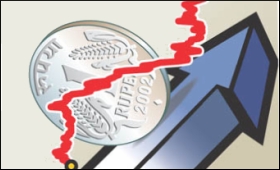|
|
|

|
'August retail inflation expected to remain high'
|
|

|
|
| Top Stories |
 |
|
|
|
SME Times News Bureau | 14 Sep, 2020
The Covid-19 induced supply-side constraints are expected to keep
India's retail price inflation at an elevated level, consequently,
eroding chances of a RBI lending rate cut.
Accordingly, leading economists, pegged the range of consumer price inflation numbers for August at 6.5-7.1 per cent.
The inflationary pressure has been mounting ever since measures to curb the pandemic were introduced.
Resultantly, these curbs have heavily dented transport, supply chains, manufacturing, services and other sectors.
"We
expect CPI print to come in the range of 6.3 to 6.7 per cent in August.
The supply side disturbances still persist. Consequently, we also do
not expect rate cut in the next policy review," Sunil Kumar Sinha,
Principal Economist, India Ratings & Research told IANS.
"However, going forward food prices on account of a healthy kharif output is likely to come down."
In
terms of supply-side constraints, industry watchers, cited issues such
as bottlenecks to transport, labour and working capital availability.
"The
ongoing supply constraints and the logistical bottlenecks arising from
the intermittent lockdowns may continue to keep food inflation at
elevated levels despite a healthy growth in the agricultural sector,"
said Suman Chowdhury, Chief Analytical Officer at Acuite Ratings and
Research.
"We believe that any further cut in rates at this stage may not contribute to higher consumption demand."
Besides, lower growth and rising inflationary pressure has again pointed towards the possibility of 'Stagflation'.
This economic trend is marked by rising inflation and falling GDP growth.
In
terms of slowdown, India's GDP has contracted by 24 per cent a
year-on-year basis for three months to June 2020, the sharpest decline
among major economies.
"Consistent supply-side price shocks both
on food and non-food segments and higher administrative costs have added
upside bias to our inflation trajectory," said Madhavi Arora, Lead
Economist, FX and Rates for Ede lweiss Securities.
"We now see
inflation hovering much above 6 per cent in the near-term, and averaging
more than 5.5 per cent in FY21. Given high and uncertain inflation
dynamics being MPC's rationale to pause in August, our inflation
trajectory suggests that technically the next opportune time to cut may
not come before the end of 3QFY21."
The central bank's target for retail inflation is set within a band of 4 per cent with an elasticity of +/-2 per cent.
Recent
rise in retail inflation had led the RBI's MPC to hold the interest
rates in August and has diminished the likelihood of any further rate
cut in the near term.
"We expect some softening in the cpi inflation to 6.4 per cent in August 2020," said Aditi Nayar, Principal Economist, ICRA.
"However,
the spike in vegetable prices may result in a reversal in this trend in
September 2020. The chances of an October rate cut seem minimal."
According
to M. Govinda Rao, Chief Economic Advisor, Brickwork Ratings: "The RBI
will continue with the current accommodative stance by conducting more
OMO's. The current level of inflation is not due to demand, but mainly
due to supply constraints."
"As the restrictions in the economy
progressively relaxed, the capacity utilization will improve and the
supply constraints will ease to stabilize both output and prices."
Last
month, official data showed that a substantial rise in food prices
lifted India's July retail inflation to 6.93 per cent from 6.23 per cent
in June.
India's consumer food price index during the month under review rose to 9.62 per cent from 8.72 per cent reported for June 2020.
|
|
|
| |
|
|
|
|
|
|
|
|
|
|
|
|
|
|
| |
| Customs Exchange Rates |
| Currency |
Import |
Export |
US Dollar
|
₹91.25
|
₹89.55 |
UK Pound
|
₹122.85
|
₹118.85 |
Euro
|
₹107.95
|
₹104.3 |
| Japanese
Yen |
₹59 |
₹57.1 |
| As on 29 Dec, 2025 |
|
|
| Daily Poll |
 |
 |
| What is your biggest hurdle to scaling right now? |
|
|
|
|
|
| Commented Stories |
 |
|
|
|
|
|
| |
|